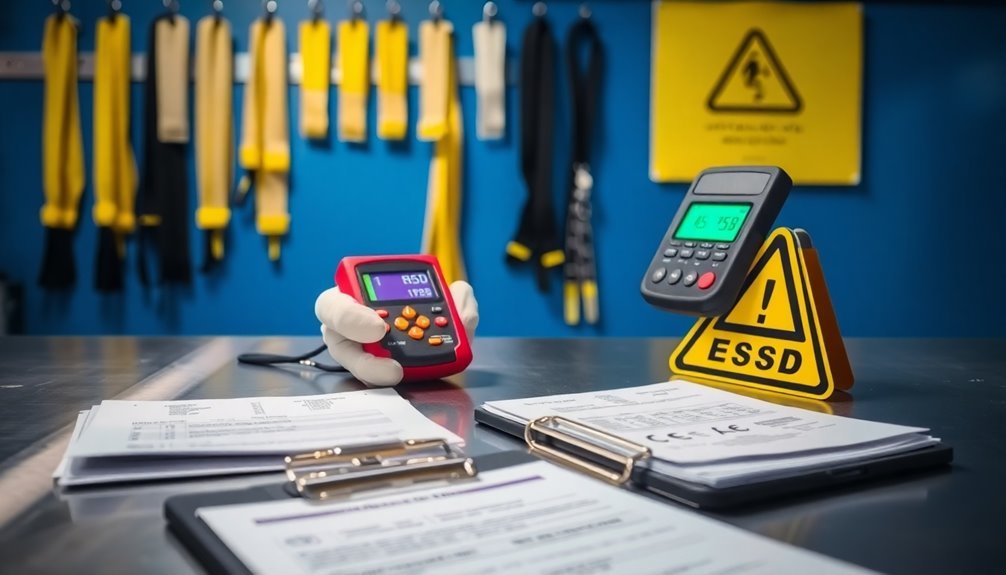To build an effective static control program, you'll need to comply with ANSI/ESD S20.20 standards and establish proper grounding systems throughout your facility. You must implement key technical requirements like static-dissipative work surfaces, personnel grounding equipment, and defined Electrostatic Protected Areas (EPAs). Your program should include extensive staff training, regular compliance verification, and detailed documentation of all procedures and test results. Proper protective measures include using ESD-safe clothing, footwear, and monitoring equipment. The success of your static control program depends on how thoroughly you understand and execute these fundamental elements.
Understanding ESD Program Requirements

Establishing an effective ESD control program requires strict adherence to industry standards and guidelines. You'll need to focus on ANSI/ESD S20.20 as your primary standard while following the thorough guidelines provided by the Electrostatic Discharge Association (ESDA).
Your program must account for various device sensitivity classifications, including Human Body Model (HBM), Machine Model (MM), and Charged Device Model (CDM). Regular auditing is essential to evaluate your program's effectiveness and maintain compliance.
To build a solid foundation, you'll need to develop detailed written procedures and specifications that cover all aspects of ESD protection. These documents should be distributed across departments and integrated into your company's existing operations.
When designing your program, verify it's tailored to protect your specific ESDS devices and meets both administrative and technical requirements for ANSI/ESD S20.20 and ISO 9000 certification.
You can't overlook the importance of securing top management support for your ESD control initiatives. Their backing is vital for successful implementation and maintaining program effectiveness.
Remember to design your program with flexibility in mind, allowing for adjustments as your company's needs evolve or when new requirements emerge.
Key Components of Static Control
Success in static control relies on implementing several critical components that work together as an integrated system. You'll need to focus on proper grounding techniques, personnel safety measures, and appropriate material selection to create an effective static control environment. The key is maintaining all components and personnel at the same electrical potential through a common point ground system.
When building your static control program, make sure you've incorporated these fundamental elements:
- Grounded static dissipative worksurfaces that control charges on equipment and production aids
- Personnel grounding systems using wrist straps with total resistance under 35 megohms
- Conductive or static dissipative holding fixtures and hand tools
- Three-prong grounded AC plugs for all electrical equipment
- Static control clothing and footwear to minimize charge generation
You'll want to pay special attention to your Electrostatic Protected Areas (EPAs), where you'll implement these controls most stringently. Human movement alone can generate thousands of static volts, making personnel control measures especially critical in these areas.
Remember that while ionization can help reduce static charges, it shouldn't be your primary control method. Instead, focus on establishing proper grounding connections and using appropriate static control materials throughout your workspace.
Regular evaluation and adjustment of these components will guarantee your program's continued effectiveness.
Personnel Training and Certification

You'll need to maintain detailed records of all ESD training activities, including attendance sheets, course materials, and completion certificates to meet ANSI/ESD S20.20 requirements.
Your training documentation should track initial and recurrent training dates, demonstrating that personnel receive updated instruction at regular intervals.
Establishing a comprehensive training plan is essential to ensure all personnel, including managers, supervisors, and temporary workers, receive proper ESD awareness education.
To verify ESD control competency, you must conduct practical assessments that evaluate employees' understanding of proper grounding techniques, handling procedures, and use of ESD protective equipment.
Training Documentation Requirements
A thorough training documentation system forms the backbone of any effective ESD control program. You'll need to maintain detailed records that demonstrate your organization's commitment to ESD control and verify that employees understand their roles in the program.
Your documentation should capture both initial and recurring training activities, including the various tools and methods used for instruction. Regular compliance verification audits are performed monthly to ensure proper implementation of training procedures.
To build an extensive training documentation system, guarantee you're tracking these essential elements:
- Written ESD control plans that outline specific training requirements and compliance verification procedures
- Records of training sessions, including dates, attendees, and the specific content covered
- Documentation of different training methods used (DVDs, computer-based materials, technical papers)
- Performance evaluations that measure employee understanding and competency
- Trend charts and audit records showing program effectiveness and areas for improvement
Your documentation system should reflect the program's consistency across different facilities and cultural contexts. When you're maintaining these records, remember to include any certification details, exam results, and renewal dates for certified personnel.
This documentation will prove invaluable during audits and help you implement necessary corrective actions while supporting continuous improvement efforts.
ESD Competency Assessment Methods
Professional ESD competency assessment requires a multi-faceted approach to verify that personnel can effectively handle static-sensitive devices. You'll need to implement both theoretical and practical evaluations to confirm that your team maintains compliance with ANSI/ESD S20.20 and IEC 61340-5-1 standards. Achieving technical excellence through iNARTE certification programs aligns with established industry competency criteria.
| Assessment Type | Key Components |
|---|---|
| Written Exams | Technical knowledge validation, understanding of ESD principles |
| Practical Demos | Hands-on skills verification, proper handling techniques |
| Observational Checks | Real-time monitoring, compliance verification during tasks |
Your assessment program should include specialized training modules tailored to specific job roles, with regular practical demonstrations to verify proper ESD control procedures. You'll want to establish clear technical competency criteria and implement continuing professional development programs to maintain expertise. Consider incorporating certification programs like iNARTE to establish a recognized standard of excellence.
Don't forget to conduct regular audits and compliance checks to verify the effectiveness of your ESD control program. Your assessment methods should align with your training documentation and include scheduled evaluations. Remember that certification renewal processes are essential for maintaining ongoing competency and keeping up with evolving standards.
Static-Safe Work Areas
Creating static-safe work areas requires careful attention to both physical design and equipment selection. Your workspace must incorporate static-dissipative materials and proper grounding systems to effectively protect sensitive electronic components. Maintaining appropriate humidity control measures helps minimize static charge generation and accumulation in sensitive areas.
You'll need to establish designated Electrostatic Protected Areas (EPAs) that meet international standards like ANSI/ESD S20.20 and IEC 61340-5-1.
Essential components of a static-safe work area include:
- Static-dissipative work surfaces made from rubber or vinyl materials
- Common point grounding systems with 10mm snap connections every 10 feet
- ESD flooring with proper grounding through dissipative casters
- ESD air ionizers to neutralize static buildup from insulating materials
- Static-dissipative mats for both work surfaces and floors
You'll need to outfit your personnel with appropriate ESD protective gear, including wrist straps, ESD footwear, and protective jackets.
Don't forget to implement regular evaluation procedures to maintain the effectiveness of your static control measures. Your ESD control program should document all procedures and training requirements, ensuring everyone understands proper handling techniques.
Remember that successful static control depends on consistent application of these protective measures throughout your designated work areas.
Monitoring and Testing Procedures

Maintaining an effective static control program requires thorough monitoring and testing procedures to guarantee consistent protection of sensitive components. You'll need to implement various testing methods, including electrical resistance testing, body voltage measurements, and resistance-to-ground verification, to confirm your ESD floors meet specified standards. Proper testing should aim to keep resistance levels between 1.0 x 10E6 and 1.0 x 10E9 ohms for communications facility floors.
Regular compliance verification audits are essential to monitor your program's effectiveness. You'll want to use detailed checklists and sampling techniques to verify that all ESD control procedures are being followed correctly.
Your audit components should include exhaustive floor inspections, system evaluations, and resistance testing to identify potential issues before they become problems.
To maintain ISO-9000 compliance and track your program's success, you'll need to keep detailed records of all tests and audits. Set up a regular schedule for quality process checking, including daily, weekly, and monthly visual and electrical checks.
Don't forget to maintain trend charts to help you spot patterns and trigger corrective actions when needed. By implementing these monitoring procedures, you'll confirm your static control program continues to protect your sensitive components effectively.
Documentation and Record Keeping
To maintain an effective static control program, you'll need a thorough set of documents that clearly outline your ESD control procedures, training requirements, and verification processes.
Your documentation must include detailed technical specifications, compliance verification plans, and procedures for identifying ESD-sensitive items. Regular program updates and reviews are essential for ensuring the program maintains its effectiveness over time.
You must also keep meticulous audit trails of all training records, test measurements, and corrective actions to demonstrate ongoing compliance with standards like ANSI/ESD S20.20-2014.
Required Program Documents
Three core components form the foundation of a robust static control program's documentation system: compliance verification plans, detailed records, and technical documentation. You'll need to establish these elements to guarantee your program meets industry standards and maintains proper traceability.
Your documentation must include both hard-copy and electronic records that demonstrate conformity to technical requirements. When creating your documentation system, focus on implementing clear indexing methods and access controls to protect sensitive information while maintaining accessibility for authorized personnel.
Essential documents you'll need to maintain include:
- Compliance verification plans detailing how you'll meet technical requirements
- Quality and technical records showing measurements and process controls
- Training documentation for personnel education and certification
- Calibration records for testing equipment and verification tools
- A qualified products list (QPL) of approved ESD control items
You'll need to establish specific procedures for creating, maintaining, and storing these records. Remember to set appropriate retention periods based on regulatory requirements and implement systematic filing methods that guarantee easy retrieval when needed.
Your documentation system should support both traceability and repeatability of all ESD control processes.
Audit Trail Maintenance
Building on your documentation system, a well-structured audit trail serves as your program's historical record and verification backbone. You'll need to maintain thorough records of all program activities, which are essential for quality control, compliance verification, and continuous improvement initiatives.
These records help you detect deviations from procedures and implement necessary corrective actions promptly.
You should conduct regular audits at least six times annually, though monthly assessments are preferable. Use statistical sampling techniques to evaluate work areas, and adjust your audit frequency based on results – increasing checks where problems persist and reducing them where compliance is consistent.
Your audit program should encompass three key areas: program management, quality process verification, and workplace assessments.
Make sure you're maintaining detailed records using consistent checklists and dedicated audit tools. You'll want to generate trend charts and extensive reports that trigger corrective actions when needed.
Remember to provide continuous feedback to both employees and management, as this communication is crucial for program success.
Your audit trail isn't just about compliance with standards like ISO-9000; it's a powerful tool for strengthening management commitment and driving ongoing program improvements.
ESD Protection Equipment Standards

Safety regulations require precise standards for ESD protection equipment to prevent static discharge damage in sensitive environments. You'll need to guarantee your equipment meets specific resistance requirements across wrist straps, garments, and footwear systems.
Wrist straps must maintain less than 3.5 x 10^7 ohms resistance and require daily testing, while garments should be static dissipative with similar resistance levels. Footwear and flooring systems must stay under 1.0 x 10^9 ohms to maintain effective grounding.
Your ESD protection program must include these critical elements:
- Wrist straps bonded to ground with interior resistance of 1.0 x 10^5 ohms and exterior resistance of 1.0 x 10^7 ohms
- Static dissipative garments meeting ANSI/ESD STM2.1 standards with regular verification testing
- Footwear and flooring systems compliant with ANSI/ESD STM97.1 standards
- Environmental controls maintaining 30-70% humidity levels
- Air ionizers in areas where grounding isn't practical
You'll need to maintain strict environmental controls in ESD-protected areas, prohibiting smoking, eating, and drinking.
Remember to use only approved tools and materials while restricting access to trained personnel who understand these requirements.
Grounding System Implementation
Proper grounding systems serve as the foundation for any effective ESD control program. You'll need to establish a common point ground connected to your equipment grounding conductor, guaranteeing all elements maintain less than 1.0 ohm impedance. This creates an equipotential bond that eliminates dangerous voltage differences between surfaces and personnel.
To implement your grounding system, start by connecting all ESD control elements to your facility's three-wire electrical system ground. You'll want to add auxiliary grounds when needed, but make sure they're bonded to your equipment grounding conductor with resistance under 25 ohms.
For personnel protection, you must provide either wrist straps or a combination of ESD footwear and flooring systems.
Your workstations require special attention – connect all components to the same electrical ground point. In clean rooms, you'll need specialized ESD floors paired with conductive footwear. Don't forget to ground your holding fixtures and equipment using conductive or static dissipative materials.
Remember to regularly test and maintain your grounding systems to guarantee they're meeting ANSI/ESD S20.20-2021 standards and providing consistent protection for your sensitive devices.
Program Auditing and Assessment

Regular program auditing forms a critical pillar of any effective ESD control strategy. You'll need to implement various types of audits, including program management reviews, quality process checks, workplace inspections, compliance verification, and statistical sampling analyses.
Each audit type serves a specific purpose in maintaining your ESD control program's integrity and effectiveness.
To maximize the value of your auditing efforts, you should guarantee they align with your Compliance Verification Plan and maintain detailed documentation of test methods and equipment used. Your audits will help verify that you're meeting industry standards like ANSI/ESD S20.20 while identifying areas for improvement.
Key benefits you'll gain from a robust auditing program include:
- Early detection of potential ESD control failures before they impact production
- Clear identification of areas requiring personnel retraining
- Verification that your ESD procedures are consistently followed
- Documentation to support ISO-9000 compliance requirements
- Data-driven insights for continuous program improvement
Remember to leverage your audit findings to implement corrective actions promptly. This proactive approach helps optimize your resources while improving yields, productivity, and overall operational capacity.
Frequently Asked Questions
How Often Should ESD Protective Packaging Materials Be Replaced?
You'll need to replace ESD protective packaging based on its condition, usage frequency, and manufacturer guidelines. Replace immediately if you notice wear, damage, or degraded antistatic properties during your regular inspections.
What Humidity Levels Are Optimal for Minimizing Static Electricity Buildup?
You'll want to maintain relative humidity between 40-60% for effective static control. For best results, keep levels above 55%, which will eliminate static buildup entirely. Lower humidity allows dangerous charge accumulation.
Can Regular Shoes Be Modified for ESD Protection?
No, you shouldn't modify regular shoes for ESD protection. They lack the necessary conductive materials and proper certification. You'll need to use properly manufactured ESD footwear to guarantee reliable static dissipation and workplace safety.
How Do Temperature Fluctuations Affect ESD Control Effectiveness?
You'll notice reduced ESD protection effectiveness as temperatures rise, with breakdown voltages dropping by up to 27.32%. This makes your devices more susceptible to damage, requiring extra precautions in hot environments.
Are Wireless Devices Allowed in Esd-Protected Areas?
You shouldn't use wireless devices in ESD-protected areas. They're not compliant with ANSI/ESD S20.20 standards and can introduce uncontrolled static risks that may damage sensitive components. Stick to properly grounded equipment instead.
In Summary
You'll need to maintain your static control program through regular auditing, thorough documentation, and continuous improvement. Don't skip periodic assessments of your ESD protection measures and personnel training. Make sure you're keeping detailed records of all testing and monitoring activities. By following these essential standards and staying vigilant with your program requirements, you'll protect sensitive components and maintain a reliable static-safe environment.





Leave a Reply